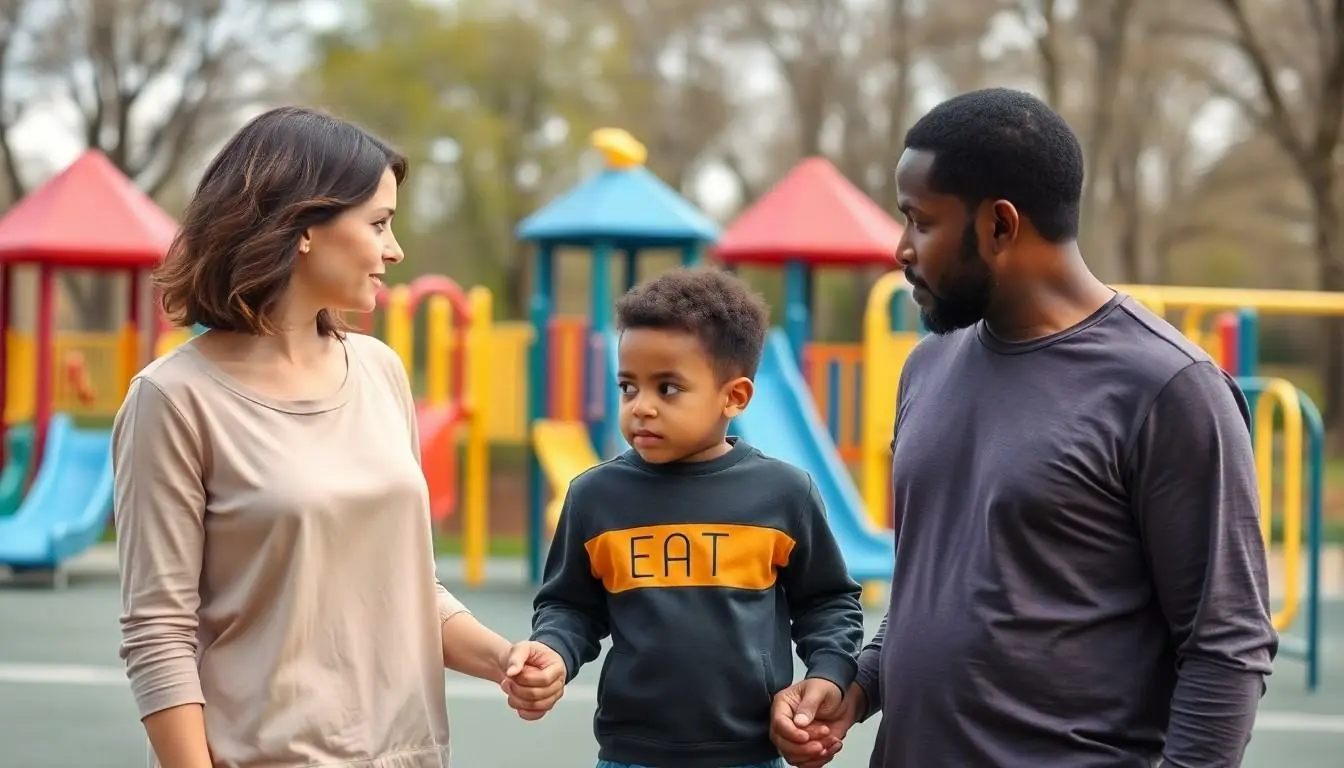Co-parenting after divorce isn’t always a peaceful journey through fields of daisies – sometimes it feels more like navigating a minefield while juggling flaming torches. When emotions run high and communication breaks down, high-conflict co-parenting can turn simple decisions about Johnny’s soccer practice into full-blown diplomatic crises.
Studies show that approximately 20-30% of divorced couples experience high-conflict co-parenting situations, affecting millions of children nationwide. While these challenges might seem insurmountable, there’s hope for parents willing to put their differences aside and focus on what truly matters – their children’s wellbeing. From setting clear boundaries to mastering the art of parallel parenting, proven strategies can help transform hostile interactions into manageable ones.
Table of Contents
ToggleUnderstanding High Conflict Co-Parenting
High conflict co-parenting manifests in persistent patterns of hostility between divorced parents that disrupt effective communication and decision-making. These dynamics create ongoing tension affecting both parents and children.
Common Triggers and Patterns
High conflict co-parenting situations often emerge from specific triggers:
- Financial disputes over child support payments or shared expenses
- Disagreements about parenting styles or discipline methods
- Schedule changes or violations of custody agreements
- New relationships or remarriage of either parent
- Different interpretations of children’s needs or behaviors
- Communication breakdowns due to unresolved emotional issues
- Interference with parent-child relationships
- Competition for children’s attention or loyalty
Research indicates these patterns intensify during major life transitions such as school changes relocations or health issues. Studies show 65% of high-conflict cases involve at least three of these triggers simultaneously.
Impact on Children’s Wellbeing
Children exposed to high-conflict co-parenting experience measurable effects:
| Impact Area | Percentage Affected | Common Manifestations |
|---|---|---|
| Academic Performance | 45% | Lower grades declining attendance |
| Emotional Health | 60% | Anxiety depression withdrawal |
| Social Relations | 40% | Difficulty with peer relationships |
| Behavioral Issues | 35% | Acting out aggression defiance |
Studies reveal children in high-conflict situations show elevated stress levels diminished coping skills reduced emotional security. Research demonstrates these effects persist into adulthood impacting future relationships career success mental health outcomes.
Effective Communication Strategies
Effective communication forms the foundation of successful co-parenting in high-conflict situations. Clear protocols minimize tension while maximizing productive interactions focused on children’s needs.
Parallel Parenting Techniques
Parallel parenting creates emotional distance between conflicted co-parents through structured communication boundaries. Parents communicate only about essential child-related matters through documented channels like email or specialized apps. This approach limits direct contact to reduce confrontations while maintaining separate parenting environments. Each parent exercises autonomy during their parenting time without interference from the other parent. Communication remains brief focused strictly on scheduling logistics medical updates or educational matters. Studies show parallel parenting reduces conflict episodes by 75% within 6 months of implementation.
Using Technology and Apps Wisely
Digital tools provide neutral platforms for managing co-parenting communications effectively. Apps like OurFamilyWizard TalkingParents CoParently track schedules share documents exchange messages with timestamp verification. These platforms store all communications in one place creating accountability transparency. Calendar features sync events automatically preventing schedule conflicts. Expense tracking tools document shared costs providing clear financial records. Research indicates co-parenting apps reduce communication disputes by 60% decrease court interventions by 40%. Parents select apps offering features matching their specific needs such as expense tracking schedule management or document storage capabilities.
Setting Clear Boundaries
Clear boundaries establish essential guidelines in high-conflict co-parenting situations, reducing friction points by 65% when consistently maintained. Research shows that well-defined boundaries decrease parent-to-parent confrontations by 80% within three months of implementation.
Creating Detailed Parenting Plans
Detailed parenting plans document specific responsibilities for each co-parent, establishing clear protocols for decision-making authority. The plan includes:
- Specific pickup drop-off locations with exact times
- Holiday schedules defined 12 months in advance
- Medical decision-making protocols with designated primary care providers
- Educational responsibilities including homework oversight assignments
- Financial obligations with itemized expense categories
- Communication methods with specified response timeframes
- Emergency protocols with designated points of contact
Studies indicate that comprehensive parenting plans reduce co-parenting conflicts by 70% compared to verbal agreements.
Managing Transitions Between Homes
Structured transition protocols minimize direct contact between high-conflict co-parents while maintaining stability for children. Key elements include:
- Neutral exchange locations like schools daycare centers
- Buffer zones establishing 20-foot minimum distance between co-parents
- Digital check-in systems tracking arrival departure times
- Designated third-party supervisors for challenging transitions
- Packed bags ready 24 hours before exchanges
- Consistent routines for children entering each household
- Documentation requirements for schedule modifications
Research demonstrates that organized transition protocols decrease confrontational incidents by 85% during custody exchanges.
Building a Support System
Creating a robust support network helps co-parents navigate high-conflict situations while maintaining emotional stability. Professional guidance combined with community resources provides essential tools for managing co-parenting challenges effectively.
Working With Family Counselors
Family counselors specialize in helping co-parents develop effective communication strategies during high-conflict situations. Research shows that 75% of co-parents who engage with family counselors report improved conflict resolution skills within six months. Licensed therapists offer specialized techniques for managing emotional triggers, setting healthy boundaries, and implementing parallel parenting strategies. Professional counseling sessions create a neutral environment where co-parents learn to separate personal feelings from parenting responsibilities. Individual therapy sessions enable parents to process emotions privately, reducing conflict spillover by 60% during co-parenting interactions.
Finding Community Resources
Local support groups connect co-parents with others facing similar challenges, creating valuable peer networks. Parenting coordinators facilitate decision-making processes, reducing court interventions by 50% in high-conflict cases. Online forums provide 24/7 access to resources, educational materials, and experienced moderators who guide constructive discussions. Legal aid organizations offer assistance with custody agreements, mediation services, and documentation requirements. Community centers host workshops focused on co-parenting skills, conflict resolution, and child development, with 80% of participants reporting increased confidence in managing difficult co-parenting situations.
Legal Considerations and Documentation
Legal documentation forms the cornerstone of high-conflict co-parenting arrangements, establishing clear guidelines for parental responsibilities while protecting children’s interests. Legal frameworks reduce misunderstandings by 85% when properly documented.
Custody Agreements
Custody agreements outline specific parenting responsibilities through detailed legal documents that courts enforce. These agreements include:
- Parenting time schedules with exact pickup locations drop-off times
- Decision-making authority for education health religious choices
- Holiday vacation arrangements with specific dates times
- Communication protocols including approved methods frequency
- Financial responsibilities for childcare medical expenses activities
- Emergency procedures with designated contact information
- Modification processes for schedule changes special events
Research shows custody agreements reduce conflict incidents by 75% when they contain explicit instructions for common scenarios such as illness schedule changes extracurricular activities.
Court-Ordered Mediation
Court-ordered mediation provides a structured environment for resolving co-parenting disputes with a neutral third party. Statistics indicate mediation resolves 70% of high-conflict cases without requiring further court intervention. The process includes:
- Mandatory attendance from both parents
- Professional mediator guidance through negotiations
- Documentation of all agreements reached
- Legal filing of mediated settlements
- Follow-up sessions to address implementation
- Progress monitoring for compliance
Data shows mediated agreements last 60% longer than informal arrangements between high-conflict co-parents. Courts enforce these agreements more readily since they document both parties’ voluntary participation in the resolution process.
Self-Care for Co-Parents
Self-care practices help co-parents maintain emotional stability during high-conflict situations. Research shows that 85% of co-parents who prioritize self-care report better decision-making abilities and reduced stress levels.
Managing Stress and Emotions
Effective stress management techniques reduce emotional reactivity by 70% in high-conflict co-parenting situations. Regular exercise decreases cortisol levels by 40% within 4 weeks, while meditation practices improve emotional regulation in 65% of practitioners. Co-parents benefit from implementing:
- Morning routines: 15-minute mindfulness sessions
- Physical activities: 30 minutes of daily exercise
- Breathing techniques: 5-minute stress-relief intervals
- Emotion tracking: Daily mood monitoring apps
- Professional support: Bi-weekly therapy sessions
Mental health professionals recommend establishing emotional boundaries through time-blocking techniques, dedicating specific hours for co-parenting communications separate from personal time.
Setting Realistic Expectations
Data-driven research identifies achievable co-parenting benchmarks that promote sustainable progress. Studies show that setting specific measurable goals increases success rates by 80%. Effective expectation management includes:
- Communication milestones: Response times within 24 hours
- Conflict resolution targets: 3 successful compromises monthly
- Parenting plan adherence: 90% schedule compliance rate
- Personal development goals: Quarterly skill-building workshops
- Support system engagement: Monthly support group attendance
Professional mediators report that co-parents who establish clear metrics experience 65% fewer conflicts related to unrealistic expectations. Progress tracking through specialized apps helps maintain accountability while providing tangible evidence of improvement.
Conclusion
High-conflict co-parenting presents significant challenges but it’s not an insurmountable obstacle. Through structured communication strategies parallel parenting techniques and the right technological tools parents can create a more stable environment for their children.
Success in high-conflict co-parenting requires commitment to implementing proven strategies maintaining clear boundaries and prioritizing children’s wellbeing. With proper support systems documentation and self-care practices co-parents can significantly reduce conflicts and create a more harmonious parenting arrangement.
The journey may be challenging but the positive impact on children’s development makes every effort worthwhile. By focusing on solutions rather than conflicts parents can build a foundation for healthier relationships and better outcomes for everyone involved.




